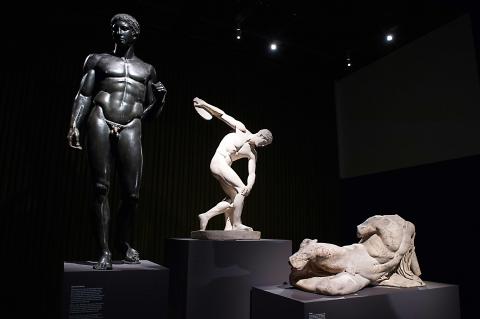The nude sculptures of the ancient Greeks depict what they believed to be the perfect human form, and the results still dazzle and move us thousands of years on, as the British Museum’s latest exhibition demonstrates.
Defining Beauty is a stunning array of sculptures and ceramics that includes some of the most familiar works of Greek antiquity.
The exhibition also compares how other cultures treated the human form and their attitudes to nudity, from the Mayans to the Assyrians.

Photo : AFP PHOTO/LEON NEAL
“The Greeks invented the human being,” Ian Jenkins, the exhibition’s curator, said, pointing to Greek philosophy, mythology and democracy, not just the aesthetics of the sculptures that dominate the exhibition.
The exhibition opens with the striking view of a nude goddess Aphrodite from behind. When visitors walk around the statue, they are met with her guarded, threatening gaze.
Though Greek in origin, she is a Roman copy. So is the discus thrower, Myron’s Diskobolos, a study in the perfect “balance of opposites,” and some of the other statues in the exhibition.
But the museum does display its own prized Greek originals which are the source of a long-running dispute with Greece. Athens has repeatedly called for the return of marble statues from the Parthenon, known as the Elgin Marbles, which were taken from Greece in 1816.
The Greek government protested angrily at the end of last year when the museum loaned one of them to Russia.
Officials at the British Museum acknowledge the difficulty in managing relations with Greece, who did not loan any items to the museum for the exhibition.
Part of the Parthenon’s frieze and the statue of Ilissos, recently returned from Russia, are on display and are a highlight of the exhibition.
Its last piece is Pheidias’s Dionysos, the Greek god of wine, theatre and religious ecstasy. The statue is placed next to a red chalk drawing of a man, drawing attention to the resemblance between the two reclining figures.
The sketch in question is Study for Adam by Michelangelo as he prepared to paint his famous fresco on the ceiling of the Sistine Chapel. Next to Dionysos, it is clear where the Italian master drew his inspiration from, consciously or not, more than a millennium later.

On April 26, The Lancet published a letter from two doctors at Taichung-based China Medical University Hospital (CMUH) warning that “Taiwan’s Health Care System is on the Brink of Collapse.” The authors said that “Years of policy inaction and mismanagement of resources have led to the National Health Insurance system operating under unsustainable conditions.” The pushback was immediate. Errors in the paper were quickly identified and publicized, to discredit the authors (the hospital apologized). CNA reported that CMUH said the letter described Taiwan in 2021 as having 62 nurses per 10,000 people, when the correct number was 78 nurses per 10,000

As we live longer, our risk of cognitive impairment is increasing. How can we delay the onset of symptoms? Do we have to give up every indulgence or can small changes make a difference? We asked neurologists for tips on how to keep our brains healthy for life. TAKE CARE OF YOUR HEALTH “All of the sensible things that apply to bodily health apply to brain health,” says Suzanne O’Sullivan, a consultant in neurology at the National Hospital for Neurology and Neurosurgery in London, and the author of The Age of Diagnosis. “When you’re 20, you can get away with absolute

May 5 to May 11 What started out as friction between Taiwanese students at Taichung First High School and a Japanese head cook escalated dramatically over the first two weeks of May 1927. It began on April 30 when the cook’s wife knew that lotus starch used in that night’s dinner had rat feces in it, but failed to inform staff until the meal was already prepared. The students believed that her silence was intentional, and filed a complaint. The school’s Japanese administrators sided with the cook’s family, dismissing the students as troublemakers and clamping down on their freedoms — with

As Donald Trump’s executive order in March led to the shuttering of Voice of America (VOA) — the global broadcaster whose roots date back to the fight against Nazi propaganda — he quickly attracted support from figures not used to aligning themselves with any US administration. Trump had ordered the US Agency for Global Media, the federal agency that funds VOA and other groups promoting independent journalism overseas, to be “eliminated to the maximum extent consistent with applicable law.” The decision suddenly halted programming in 49 languages to more than 425 million people. In Moscow, Margarita Simonyan, the hardline editor-in-chief of the